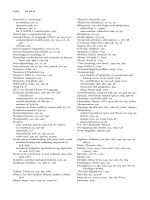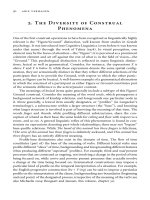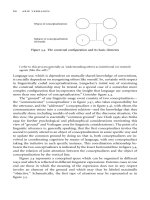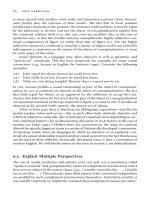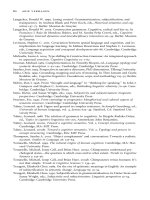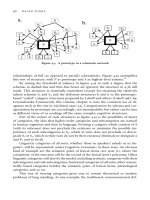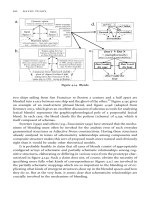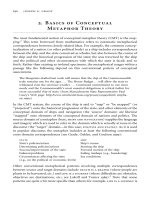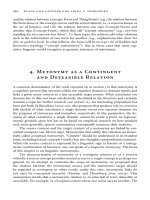The Oxford Handbook of Cognitive Linguistics Part 82 pps
Bạn đang xem bản rút gọn của tài liệu. Xem và tải ngay bản đầy đủ của tài liệu tại đây (180.68 KB, 10 trang )
Hopper, Paul J., and Sandra A. Thompson. 1980. Transitivity in grammar and discourse.
Language 56: 251–99.
Hudson, Richard. 1992. So-called ‘double objects’ and grammatical relations. Language 68:
251–76.
Janda, Laura A. 1993. A geography of case semantics: The Czech dative and the Russian
instrumental. Berlin: Mouton de Gruyter.
Keenan, Edward L. 1976. Toward a universal definition of ‘subject.’ In Charles Li, ed.,
Subject and topic 303–33. New York: Academic Press.
Keenan, Edward L. 1984. Semantic correlates of the ergative/absolutive distinction. Lin-
guistics 22: 197–223.
Kuno, Susumu. 1987. Functional syntax: Anaphora, discourse and empathy. Chicago: Uni-
versity of Chicago Press.
Lakoff, George. 1977. Linguistic gestalts. Chicago Linguistic Society 13: 236–87.
Lakoff, George. 1987. Women, fire, and dangerous things: What categories reveal about the
mind. Chicago: University of Chicago Press.
Langacker, Ronald W. 1987. Foundations of cognitive grammar. Vol. 1, Theoretical pre-
requisites. Stanford, CA: Stanford University Press.
Langacker, Ronald W. 1990. Concept, image, and symbol: The cognitive basis of grammar.
Berlin: Mouton de Gruyter.
Langacker, Ronald W. 1991. Foundations of cognitive grammar. Vol. 2, Descriptive appli-
cation. Stanford, CA: Stanford University Press.
Langacker, Ronald W. 1998. Topic, subject, and possessor. Linguistic notes from La Jolla 19:
1–28. (Revised version in Hanne Gramm Simonsen and Rolf Theil Endresen, eds.,
A cognitive approach to the verb: Morphological and constructional perspectives 11–48.
Berlin: Mouton de Gruyter, 2000)
Langacker, Ronald W. 2000. Grammar and conceptualization. Berlin: Mouton de Gruyter.
Langacker, Ronald W. 2005. Construction Grammars: cognitive, radical and less so. In
Francisco J. Ruiz de Mendoza Iba
´
n
˜
ez, and M. Sandra Pen
˜
a Cervel, eds., Cognitive
Linguistics: Internal dynamics and interdisciplinary interaction 101–59. Berlin: Mouton
de Gruyter.
Maldonado, Ricardo. 2002. Objective and subjective datives. Cognitive Linguistics 13: 1–65.
Mithun, Marianne. 1991. Active/agentive case marking and its motivations. Language 67:
510–46.
Mithun, Marianne, and Wallace Chafe. 1999. What are S, A, and O? Studies in Language 23:
569–96
Newman, John. 1996. Give: A cognitive linguistic study. Berlin: Mouton de Gruyter.
Nishimura, Yoshiki. 1993. Agentivity in cognitive grammar. In Richard A. Geiger and
Brygida Rudzka-Ostyn, eds., Conceptualizations and mental processing in language
487–530. Berlin: Mouton de Gruyter.
Onishi, Masayuki. 2001. Non-canonically marked subjects and objects: Parameters
and properties. In Alexandra Y. Aikhenvald, Robert M. W. Dixon, and Masayuki
Onishi, eds., Non-canonical marking of subjects and objects 1–51. Amsterdam: John
Benjamins.
Rappaport Hovav, Malka, and Beth Levin. 1998. Building verb meanings. In Miriam Butt
and Wilhelm Geuder, eds, The projection of arguments: Lexical and compositional
factors 97–134. Standford, CA: CSLI Publications.
Rice, Sally A. 1987. Towards a cognitive model of transitivity. PhD dissertation, University
of California at San Diego.
780 jose
´
m. garcı
´
a-miguel
Ruppenhofer, Josef, Michael Ellwood, Miriam R. L. Petruck, and Christopher R. Johnson.
2005. FrameNet: Theory and Practice. />book.html.
Smith, Michael B. 1985. Event chains, grammatical relations, and the semantics of case in
German. Chicago Linguistic Society 21: 388–407.
Smith, Michael B. 1993. Cases as conceptual categories: Evidence from German. In Richard
A. Geiger and Brygida Rudzka-Ostyn, eds., Conceptualizations and mental processing in
language 531–65. Berlin: Mouton de Gruyter.
Talmy, Leonard. 1988. Force dynamics in language and cognition. Cognitive Science 12:
49–100.
Talmy, Leonard. 1996. The windowing of attention in language. In Masayoshi Shibatani
and Sandra A. Thompson, eds., Grammatical constructions: Their form and meaning
235–87. Oxford: Clarendon Press.
Talmy, Leonard. 2000. Toward a cognitive semantics. Vol. 1, Concept structuring systems.
Cambridge, MA: MIT Press.
Taylor, John R. 1995. Linguistic categorization: Prototypes in linguistic theory. 2nd ed.
Oxford: Clarendon Press. (3rd ed., 2003)
Taylor, John R. 1998. Syntactic constructions as prototype categories. In Michael Toma-
sello, ed., The new psychology of language: Cognitive and functional approaches to
language structure 1: 177–202. Mahwah, NJ: Lawrence Erlbaum.
Tuggy, David. 1998. Giving in Nawatl. In John Newman, ed., The linguistics of giving 35–66.
Amsterdam: John Benjamins.
van der Leek, Frederike. 1996. Rigid syntax and flexible meaning: The case of the English
ditransitive. In Adele E. Goldberg, ed., Conceptual structure, discourse and language
321–32. Stanford, CA: CSLI Publications.
van der Leek, Frederike. 2000. Caused-motion and the ‘bottom-up’ role of grammar. In Ad
Foolen and Frederike van der Leek, eds., Constructions in cognitive linguistics 301–31.
Amsterdam: John Benjamins.
Va
´
zquez Rozas, Victoria. 1995. El complemento indirecto en espan
˜
ol. Santiago de Com-
postela: Servicio de Publicacio
´
ns da Universidade de Santiago de Compostela.
clause structure and transitivity 781
chapter 30
COMPLEMENTATION
michel achard
1. The Complement Relation
The term ‘‘complement’’ has a very general interpretation in Cognitive Linguistics.
For example, in Langacker’s Cognitive Grammar (Langacker 1987, 1991), a com-
plement structure corresponds to and elaborates a salient subpart of the relation
evoked by the head. For example, in the phrase under the table, the nominal the table
stands in a complement relation to the preposition under (the head), because it
corresponds to and elaborates its landmark. In that sense, complements contrast
with modifiers. In a modifier relation, the head elaborates a salient substructure of
the entity that modifies it. For example, in the phrase big tree, the head tree cor-
responds to the trajector of big and gets elaborated by it. Big therefore stands in a
modifying relation with respect to the head tree.
The amount of space allotted to this chapter makes it impossible to treat
complementation in this general sense. Consequently, we will be exclusively con-
cerned with clausal complements. For our purposes, a complement is a clause that
functions as an argument with respect to the main verb. For example, in I believe she
came back, the subordinate clause she came back elaborates the landmark of the
main verb believe.
In a way congruent with the overall cognitive linguistic goals and methods, the
main focus of the research on complementation has consisted of exploring the se-
mantic import of the complement constructions and investigating the isomorphism
that exists between the form of those constructions and their semantic-conceptual
organization both language-internally and cross-linguistically (Givo
´
n 1980, 1990;
Haiman 1985). A nonexhaustive list of the languages whose complementation systems
have been insightfully analyzed includes: Bella Coola and Lushootseed (Beck 2000),
English (Wierzbicka 1988; Dirven 1989; Langacker 1991;Verspoor1999, 2000), French
(Ruwet 1984, 1991;Achard1996, 1998, 2002a, 2002b), Korean (Horie 2000), Japanese
(Suzuki 1996, 2000;Horie2000), Spanish (Delbeque 2000), and Tsez (Polinsky
2000). Across languages, the research has mostly focused on the cross-linguistic
definition of subordination (Cristofaro 1998, 2003) or the typological dimension
of the morphosyntactic form of the complements (Givo
´
n 1980, 1990, 1995; Noonan
1985;Horie1993).
The purpose of this chapter is to present an overview of this research. While it
is clear that space limitations preclude an exhaustive presentation of any one of the
issues introduced, the examples chosen aim to provide the reader with a basic
understanding of the issues raised by cognitive linguists about complementation,
as well as the methods they have designed to answer them. Section 2 introduces the
crucial concept of ‘‘conceptual subordination.’’ Section 3 presents some of the
semantic contrasts that complement constructions code in English, Japanese, and
French. Section 4 considers the Cognitive Grammar account of raising construc-
tions in order to show that a semantically based framework can provide a satis-
factory account of phenomena traditionally regarded as purely syntactic. Section 5
summarizes and concludes this chapter.
2. Conceptual Subordination
2.1. General Issues
Because the topic of this chapter is clausal complements, we first need to briefly
introduce some basic concepts pertaining to the structure of a clause before turning
our attention to more complex constructions. Langacker (1991 : 13–95) argues that
the internal organization of a clause closely parallels that of a noun phrase and that,
like the noun phrase, it exhibits a layering of semantic functions. Just as a noun
represents a noun type, a verb stem represents a process type. Both types need to be
instantiated, that is to say, considered with respect to a particular location in their
domain of instantiation before being quantified. For verbs, the nonfinite markers
(aspect and voice, for example) provide the quantification function. The quantified
instances are finally grounded, that is, considered with respect to the speech situa-
tion. In this analysis, an infinitival complement profiles a type specification, whereas
an indicative clause profiles a grounded instance of a process type.
Independent or main clauses are usually fully grounded (finite). Complement
clauses, on the other hand, exhibit all levels of semantic elaboration. For example, in
I know that she left, the subordinate clause profiles a grounded instance of the
process of leaving. By comparison, in I want to leave, the complement clause pres-
ents leaving as a mere type. The eclecticism of its possible forms indicates that the
complementation 783
definition of a complement clause needs to remain independent from any specific
morphosyntactic realization. Langacker (1991: 436) suggests that a complement
clause is a clause whose profile is superseded by that of another (main) clause:
A main clause is the head at a particular level of organization, i.e. the clause that
lends its profile to the composite structure of a multiclausal expression. A sub-
ordinate clause is then describable as one whose profile is overridden by that of a
main clause. In a typical complement clause construction, the two clauses
combine directly and the main clause is clearly the profile determinant: I know she
left designates the process of knowing, not of leaving.
1
This overriding of the profile of the complement clause reflects the conceptual
subordination of the event coded by that clause on the event profiled by the main
clause. Langacker (1991: 440) expresses conceptual subordination in the following
fashion: ‘‘By the very nature of a complement clause, the process it describes
undergoes a kind of conceptual subordination: rather than being viewed in its own
terms as an independent object of thought, it is primarily considered for the role it
plays within the subordinate relationship expressed by the main clause.’’
Because of the iconic properties of grammatical structures (Haiman 1985),
there is a high degree of correlation between the level of semantic elaboration of
the complement clause (reflected in its morphosyntactic shape) and the degree of
independence of the subordinate event with respect to the main event. Conse-
quently, the level of conceptual integration of the subordinate event into the main
event can be evaluated. Givo
´
n(1980: 338) provides three parameters to deter-
mine the degree of independence of the subordinate event with respect to the main
event:
i) The degree to which the agent/subject/topic marking of the embedded clause
reflects the markings in independent/main clauses; ii) The degree to which in-
dependent-clause tense-aspect-modality marking of the verb is preserved in the
embedded clause; iii) The presence or degree-of-presence of predicate-raising of
the complement clause verb onto the main verb; i.e., the degree to which the
complement verb is lexicalized as one word with the main verb.
For example, in I know that she came, the subordinate clause she came is identical in
form to an independent clause. The logical subject of come is marked in the nom-
inative, as it would be in an independent clause. Furthermore, the subordinate verb
retains its own Tense-Aspect-Modality markings. In fact, the presence of the com-
plementizer that alone formally reflects the conceptual dependence of the subor-
dinate clause by introducing a distancing effect that provides a quasi-nominal
construal of that clause (Langacker 1991). By comparison, in She wants me to come
back, the form of the complement me to come back indicates that the event it codes
has a lesser degree of independence with respect to the main verb want. The logical
subject of the subordinate verb is in the accusative instead of the expected nom-
inative in an independent clause, and there are no Tense-Aspect-Modality mark-
ings on that verb. Givo
´
n’s criteria clearly show that increasing dependence on the
main event is reflected in the increasing loss of specifically verbal markings on the
784 michel achard
form that codes the subordinate event. This decrease in verbal specificity is fully
congruent with the fact that complementation is often treated syntactically as
nominalization in different languages (Beck 2000; Horie 2000; Polinsky 2000).
2.2. The Semantic Basis of Conceptual Subordination
One of the most important tasks in complementation research consists of moti-
vating the distribution of particular complement forms with the main verbs they
occur with. Givo
´
n(1980, 1990) shows that the semantics of the main verb go a long
way toward determining that distribution. His binding hierarchy explores ‘‘the
systematic isomorphism that exists between the semantics of the complement-
taking verbs, and the syntax of the verb-plus-complement constructions’’ (Givo
´
n
1990: 515). Givo
´
n’s analysis considers the form of the complement as the result of
the ‘‘binding force’’ of the main verb, that is, the influence of the main clause subject
over the complement scene. The top of the scale is composed of the manipulative
verbs, such as cause, make, and force, and the bottom consists of cognition utterance
verbs, such as know.
The ‘‘emotional factor’’ involved in certain verbs provides an additional di-
mension to the hierarchy, and yields opposite results if applied at the top or at the
bottom of the scale. ‘‘The more the subject/agent of a manipulative verb is emo-
tionally committed to the outcome encoded in the complement clause, the higher
the verb will be on the binding scale. The more emotionally committed the subject/
agent of a manipulative verb is with the outcome encoded in the complement clause,
the lower the manipulative verb will be on the binding scale’’ (Givo
´
n 1980: 337). The
two dimensions yield the following scale: the manipulative implicative verbs (make,
have, cause) occupy the top, followed by the nonimplicative and increasingly
emotion-encoding verbs, such as tell, ask, and want. Emotion-encoding cognition
verbs, such as regret, occupy a lower position, just above the nonemotive cognition
verbs, such as know, which constitute the lowest point of the scale.
The interest of Givo
´
n’s hierarchy resides in the prediction it makes for the type
of complement structure that follows each verb type.
The main purpose of this study is to show that the syntactic nature (coding) of the
complement clauses of verbs which take verbal/sentential complements is largely
predictable from their position on the scale. Not altogether unexpectedly, the
binding force of a verb roughly correlates to the degree to which its comple-
ment appears syntactically like an independent/main clause. The relation is,
however, inverse. The higher a verb is on the binding scale, the less would its
complement tend to be syntactically coded as an independent/main clause.
(Givo
´
n 1980: 337)
One example will suffice to illustrate Givo
´
n’s hierarchy. A verb at the top of the
scale, such as make, occurs with the logical subject of the subordinate verb raised in
the position of object of the main verb and a subordinate predicate in the infinitive
as in Chris made Pat cry, for example. It cannot occur with a finite complement
complementation 785
because the subordinate event lacks the independence required to be coded that
way (*Chris made that Pat cried). On the other hand, a lower verb, such as know,is
perfectly felicitous with a finite complement, the form that best approximates an
independent clause (I know that she came yesterday).
Givo
´
n’s hierarchy represents one of the most useful typologies of complement-
taking verbs because it allows us to relate seemingly very diverse constructions in
different languages. However, it cannot fully account for complement distribution,
because it is exclusively concerned with the meaning of the main verb. In partic-
ular, if it can predict the range of constructions a given verb can take, it cannot
motivate the choice of a specific construction within that range. A thorough ac-
count of complement distribution also needs to pay careful attention to the
meaning of the complement constructions themselves. This is extremely difficult to
do cross-linguistically, because the necessary generality of the analysis overlooks
the semantic subtlety of the contrasts different constructions express in individual
languages. Typological research therefore needs to be complemented by in-depth
language-specific investigations that bring to light the different kinds of semantic
contrasts various complement constructions code.
3. Semantic Contrasts
The most efficient way to present these language-specific investigations is to
consider each language separately. Two main reasons explain this strategy. First,
specific constructions code different contrasts in different languages, and these
contrasts are consistent with the global ecology of the language considered (i.e.,
other contrasts coded elsewhere in the grammar). Secondly, the morphosyntactic
means by which these constraints are expressed also obviously depend on the lexical
and structural apparatus available in the language. Consequently, the constructs
that most conveniently describe complementation systems vary substantially across
languages, and each one is best introduced in the context of the language for which
it is relevant. For this reason, this section presents an overview of the research on
the complement systems of English, Japanese, and French. Here again, the purpose
of this section is not to be exhaustive, but merely to provide the reader with an
illustration of the results obtained in those languages.
3.1. English
It is fitting to start this overview with the English situation for several reasons. First,
English has a rich system with a highly complex distribution of complements and
verb types. Secondly, the syntactic aspects of that distribution make the area of
English complementation ‘‘one of the greatest challenges to a theory of syntax
786 michel achard
based on semantic foundations’’ (Wierzbicka 1988: 23). Finally, most of the original
research on complementation was done with respect to English, and the results
obtained sparked semantic interest in complement constructions in other lan-
guages. Most of those early works (Jespersen 1909–42; Wood 1956; Bolinger 1968,
1972, 1974; Kiparsky and Kiparsky 1970; Karttunen 1971; Borkin 1973; Hooper 1975;
Ney 1981; Dixon 1984; among others) could not be called cognitive in the strictest
sense, because they predate the establishment of Cognitive Linguistics as a unified
theoretical approach. However, they are crucial in illustrating the basic tenet that
will be formulated as one of the guiding assumptions of the Cognitive Linguistics
movement, namely that ‘‘a difference in syntactic form always spells a difference in
meaning’’ (Bolinger 1968: 127).
It is a well-known fact that in English most verbs can only take specific
complements. For instance, certain verbs can only take gerund (-ing) comple-
ments while others can only be followed by to þ -ing structures, as illustrated in (1 )
and (2):
(1) a. We all wanted to stay at home.
b. *We all wanted staying at home.
(2) a. *We all kept to play.
b. We all kept playing.
The main thrust of the research on English complementation has consisted of
providing a semantic definition for the four complement types commonly found in
the language, namely, -ing -, to-, for to-, and that-complements. Once these
complement types are recognized as specific constructions with their own semantic
import, their syntactic behavior, that is, their distribution with the relevant verb
classes, is primarily a matter of semantic compatibility between meaningful ele-
ments. It is simply impossible to do justice to all the solutions proposed in the
literature. Consequently, I will primarily base this overview on Wierzbicka’s (1988)
solution and refer the reader to the aforementioned works, as well as Dirven (1989),
Duffley (1999), Verspoor (1999, 2000), and Smith and Escobedo (2001) for addi-
tional information. Wierzbicka’s analysis has been chosen because it represents
perhaps the most complete and best-articulated account of the semantic base of the
English complementation system. It provides a thorough semantic analysis of -ing-,
to-, for to-, and that-complements and convincingly argues that the distribution
of these four forms is directly predictable from their meanings.
There are two kinds of -ing-complements: temporal and nontemporal. Tem-
poral complements originate in situations where -ing combines with the temporal
semantic verb types of events, processes, or actions, entities for which time is
relevant. Nontemporal complements arise when -ing combines with the semantic
verb types of facts and possibilities, entities for which time is irrelevant. For the
temporal complements, the presence of -ing indicates some element of ‘sameness of
time’ between the main and subordinate verb. This constraint is obviously irrele-
vant with the nontemporal complements. This contrast is illustrated in (3) and (4).
The sentence in (4) is adapted from Wierzbicka (1988: 69).
complementation 787
(3) She enjoyed watching the movie.
(4) John regretted (yesterday) quarreling with Jane (last month).
In (3), the complement refers to the action of watching the movie. Consequently,
because actions are time-sensitive, the enjoying and the watching must occur at the
same time. In (4), on the other hand, the complement refers to the nontemporal
fact of quarreling with Jane. The sameness of time constraint is therefore irrelevant,
and the quarreling is rightfully construed as preceding the regretting.
To-complements are particularly sensitive to two semantic notions. First, they
are associated with the ‘‘first-person mode,’’ that is, they uniquely describe what
the conceptualizer himself or herself knows, thinks, or wants, as opposed to the
experience of other conceptualizers. Secondly, they always contain some form of
‘‘future orientation.’’
2
The future orientation of the to-complements makes them obviously different
from the -ing-forms, which accounts for the following contrast (from Wierzbicka
1988: 64):
(5) He tried frying the mushrooms.
(6) He tried to fry the mushrooms.
Because of the sameness-of-time constraint imposed by the -ing-complement in
(5), the trying and the frying are construed as occurring at the same time. In (6),
because of the future orientation of the to-complement, the trying necessarily
precedes the frying. The choice between the two constructions is obviously de-
termined by the speaker’s evaluation of which one best structures the scene he or
she wants to describe (Duffley 1999; Smith and Escobedo 2001).
For to-complements conflict with to-complements in two important re-
spects. The first is the level of confidence with which the accomplishment of the
process in the complement is envisaged. This is illustrated in (7) and (8) (from
Wierzbicka 1988: 167):
(7) a. She expected him to come.
b. *She expected for him to come.
(8) a. *She waited him to come.
b. She waited for him to come.
The verb expect in (7) indicates more confidence in the realization of the coming
process than wait in (8). Consequently, expect is possible with to-, but infelicitous
with for to-complements. Wait conversely occurs with for to but not with to.
The second area where the for to- and to-complements contrast concerns
their ‘self’ versus ‘other’ orientation. Whereas to -complements describe the
speaker’s self experience, for to-complements usually express the experience of
other conceptualizers.
3
The ‘other’ orientation of for to is often expressed by the
presence of different subjects for the main and subordinate verbs. The respective
orientations of to- and for to-complements toward the self and others accounts
for the contrast in (9) and (10) (from Wierzbicka 1988: 167):
788 michel achard
(9) She was keen to go.
(10) a. She was keen for him to go.
b. *She was keen for herself to go.
While it is felicitous to describe the speaker’s experience in (9), to is infelicitous to
describe another conceptualizer’s experience in (10), even if the self is construed
like an other. Finally, the for to-complements have an ‘‘anti-assertive’’ value that
emphasizes its connection with the subjunctive mood found in other languages.
That-complements basically pertain to knowledge and the intellectual appre-
hension of a given entity. This yields the well-documented contrast illustrated in
(11) and (12):
(11) I saw him coming.
(12) I saw that he had come.
The presence of -ing in (11) indicates that the main and subordinate processes occur
at the same time and that the process of coming was directly perceived. The pres-
ence of the that-clause in (12) indicates a more mental act that did not necessarily
result from direct perception (Bolinger 1968; Borkin 1973).
4
3.2. Japanese
In Japanese, complementation essentially reduces to the kind of complementizer
used and to whether or not that complementizer functions as a nominalizer. The
language has several different complementizers, the most frequent of which are no,
koto, and to.
5
The use of these three complementizers is illustrated in (13)–(15). The
examples are from Horie (2000):
(13) Mary-wa [John-ga toori-o wataru] no-o mi-ta.
M top J nom street-acc cross nr-acc see-pst
‘Mary saw John cross the street.’
(14) Mary-wa [John-ga toori-o watat-ta] koto-o sit-ta.
M top J nom street-acc cross-pst nr-acc know-pst
‘Mary learned that John had crossed the street.’
(15)‘‘Asita-wa ko-nai yo,’’ to (*o) it-ta.
tomorrow-top come-neg sfp comp acc say-pst
‘He said: ‘‘won’t come tomorrow’’.’
Suzuki (2000: 34) characterizes the main structural difference between the three
complementizers in the following way. ‘‘While no and koto are nominalizers and
thus incorporate their complement as the object of the matrix verb, to does not
nominalize the complement and thus does not incorporate the complement into
the rest of the sentence as well as the nominalizers do.’’ The impossibility for to to
be a nominalizer is illustrated in (15) by the infelicity of the accusative marker -o.
6
The research on Japanese complementation constructions has mostly centered
on precisely establishing the nature of the contrast between the constructions
complementation 789
